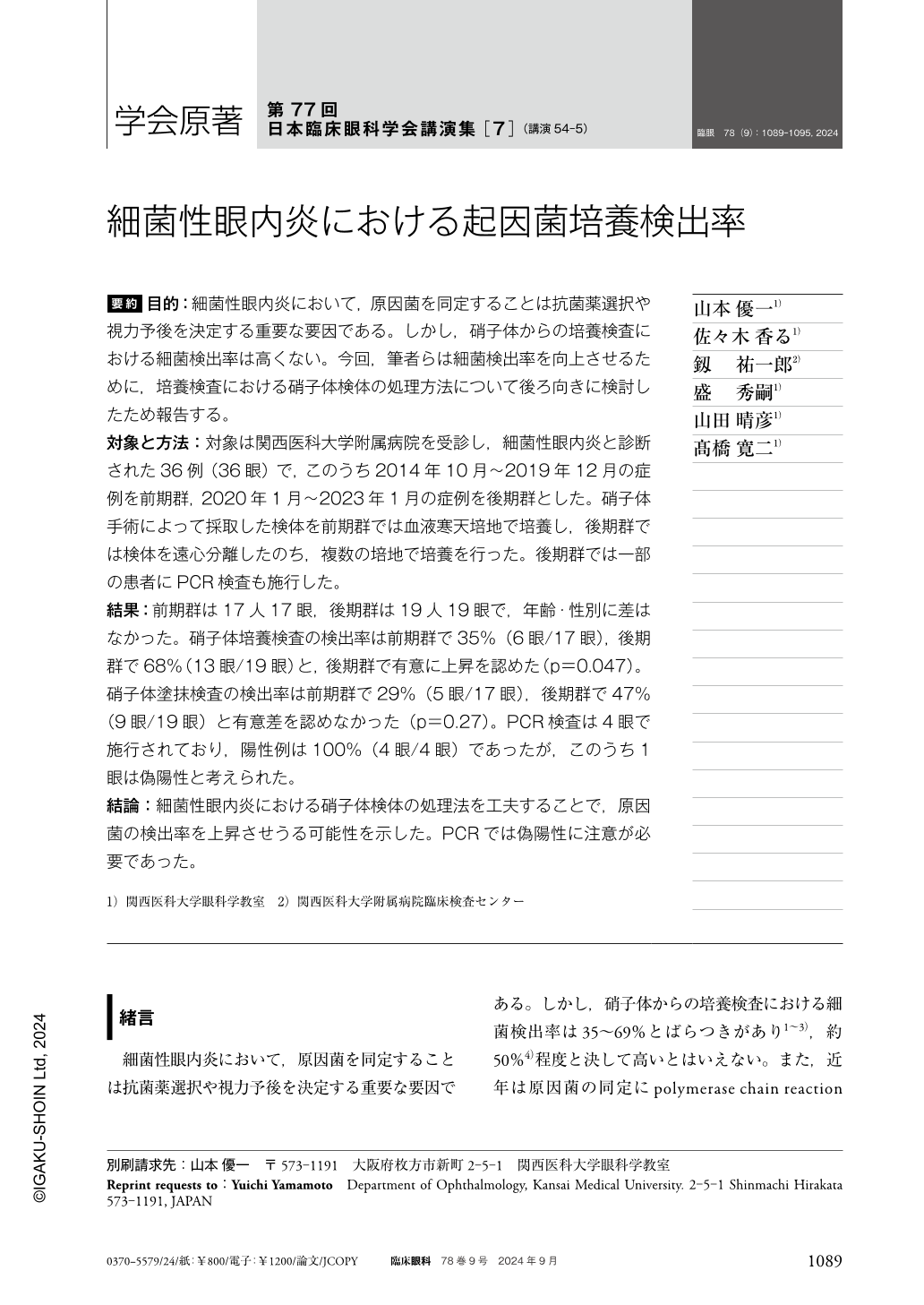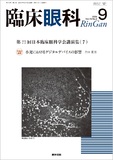Japanese
English
- 有料閲覧
- Abstract 文献概要
- 1ページ目 Look Inside
- 参考文献 Reference
要約 目的:細菌性眼内炎において,原因菌を同定することは抗菌薬選択や視力予後を決定する重要な要因である。しかし,硝子体からの培養検査における細菌検出率は高くない。今回,筆者らは細菌検出率を向上させるために,培養検査における硝子体検体の処理方法について後ろ向きに検討したため報告する。
対象と方法:対象は関西医科大学附属病院を受診し,細菌性眼内炎と診断された36例(36眼)で,このうち2014年10月〜2019年12月の症例を前期群,2020年1月〜2023年1月の症例を後期群とした。硝子体手術によって採取した検体を前期群では血液寒天培地で培養し,後期群では検体を遠心分離したのち,複数の培地で培養を行った。後期群では一部の患者にPCR検査も施行した。
結果:前期群は17人17眼,後期群は19人19眼で,年齢・性別に差はなかった。硝子体培養検査の検出率は前期群で35%(6眼/17眼),後期群で68%(13眼/19眼)と,後期群で有意に上昇を認めた(p=0.047)。硝子体塗抹検査の検出率は前期群で29%(5眼/17眼),後期群で47%(9眼/19眼)と有意差を認めなかった(p=0.27)。PCR検査は4眼で施行されており,陽性例は100%(4眼/4眼)であったが,このうち1眼は偽陽性と考えられた。
結論:細菌性眼内炎における硝子体検体の処理法を工夫することで,原因菌の検出率を上昇させうる可能性を示した。PCRでは偽陽性に注意が必要であった。
Abstract Purpose:In bacterial endophthalmitis, identification of the causative bacteria is an important factor in determining the necessary antimicrobial therapy as well as patients' visual prognosis. However, the detection rate of bacteria in vitreous cultures is typically low. In this study, we retrospectively investigated whether the processing methods of vitreous specimens may affect the bacterial detection rate.
Subjects and methods:The subjects were patients who visited Kansai Medical University Hospital and were diagnosed with bacterial endophthalmitis. Patients from October 2014 to December 2019 were defined as the early stage group(group A), and patients from January 2020 to January 2023 were defined as the late stage group(group B). In group A, the specimens collected by vitrectomy were cultured on blood agar medium. Meanwhile, in group B, the specimens were centrifuged at 5000 rpm for 15 please add a space between 15 and min and the pellets were subsequently cultured on several kinds of media. Some specimens from the group B patients were used for PCR testing.
Results:Group A comprised 17 eyes of 17 patients and group B comprised 19 eyes of 19 patients in group B. The detection rate of vitreous cultures was significantly higher in group B(13/19 eyes:68%)than in group A(6/17 eyes:35%)(p=0.047). Meanwhile, the detection rate of vitreous smears was 29%(5/17 eyes)in group A and 47%(9/19 eyes)in group B, with no significant difference between them(p=0.27). PCR was performed in four eyes, all of which were positive. In two of these cases, the organisms detected by PCR were different from those detected by vitreous culture.
Conclusion:We have shown that vitreous sample processing methods may affect the detection rate of causative organisms in bacterial endophthalmitis.

Copyright © 2024, Igaku-Shoin Ltd. All rights reserved.


